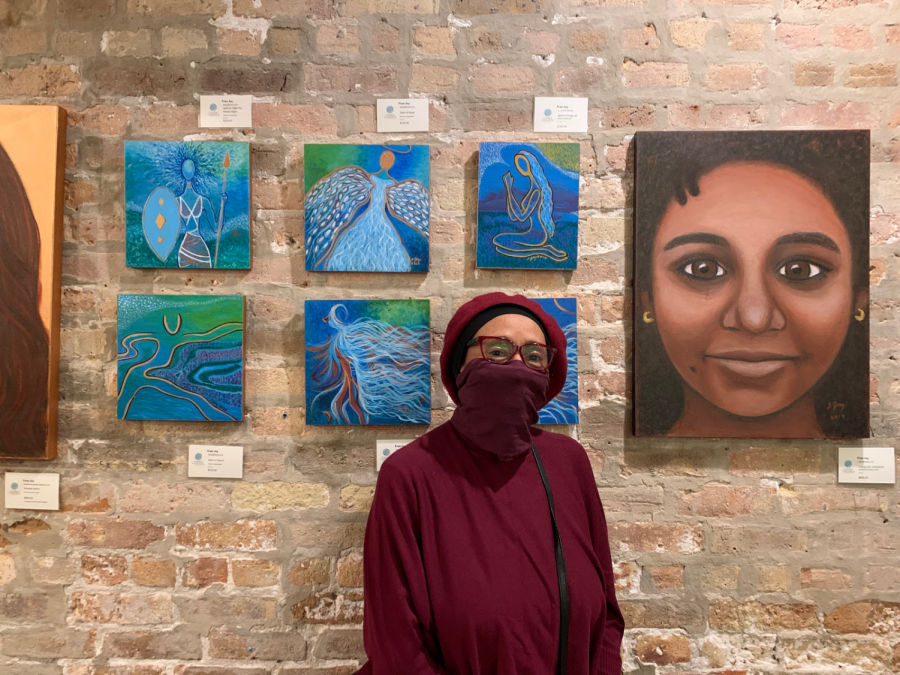At the intersection of art and activism, Fran Joy doesn’t want you to look away
Erica Davis/The Daily Northwestern
Fran Joy stands in front of her paintings at a show at Creative Coworking, 922 Davis St., on Saturday.
November 20, 2020
When Trayvon Martin was killed by George Zimmerman in 2012, it was Evanston artist Fran Joy’s birthday. As she celebrated another year of life, Trayvon Martin’s family mourned the loss of his.
Joy has experienced loss and gun violence herself, and Martin’s murder had such a profound impact on her that she sought an outlet to express her anger and frustration. At the time, she found inspiration in songwriter Nina Simone’s words. “You can’t help it. An artist’s duty, as far as I’m concerned, is to reflect the times.”
To reflect what Joy called “the illusion of justice” in America, she said she began working on a painting of a slowly grinding gear in the style of surrealism. Surrounding the gear is the Martin Luther King Jr. quote, “The arc of the moral universe is long, but it bends toward justice,” which Joy said reminds her that in the end, justice will prevail.
After painting “Wheels of Justice,” Joy’s portfolio grew to include portraits of Tamir Rice, Maya Angelou, Nelson Mandela, Sandra Bland and Barack Obama, among others. She said she highlights figures that need to be remembered for their strength of character or for the injustice committed against them.
In her portraits, some of which have been featured in the Garrett- Evangelical Theological Seminary, Joy puts emphasis on the eyes, enlarging them so that the viewer has to engage with the painting and the person behind it, she said.
The eyes in “Portrait of Emmett Till,” Joy’s favorite piece, are green and outlined in black, staring widely from the upper third of the canvas. Though Joy said the piece was emotionally draining to create, she felt she had received a spiritual message to show Till as he was in life.
“I felt when I did the piece that he wanted to be remembered as he was: the good looking. mischievous young guy,” Joy said. “I felt like it wouldn’t let me finish until that would satisfy his spirit.”
Joy said her art is currently inspired by a sense of ancestry and the restoration of the Black spirit, but before she was painting relevant figures, her artistic career began in kindergarten, when she was introduced to finger painting. In her small hometown in southern Illinois, Joy said she enjoyed the freedom to create art while also pursuing other subjects.
Joy moved to Chicago to attend Columbia College Chicago, where she took various art courses, but she didn’t re-enter the art world until she got a job at a local Evanston gallery. When her husband died eight years ago, Joy said she completely threw herself back into her own art.
Joy and her husband collected African masks together for many years, and she said they made her feel grounded in her ancestry. When she could no longer afford to buy the African art she loved, she began creating it with her own brush.
“There’s this kind of sense of overlooking or protecting me,” she said.
For the 40 years Ann Johnson has been friends with Joy, art has been the core of her friend’s being, she said. It was in recent years, however, as Joy began to intertwine activism into her work, that her art began to bloom, Johnson said.
Joy’s paintings are an important guide for the Evanston community in their understanding of social issues past and present, Johnson said.
“Simply put, her work speaks for the past, boldly addresses the present and provides clarity for the futures we want to see in the world,” she said.
Dino Robinson, who sat with Joy on the Evanston Arts Council, said Joy draws on current events, as well as her spirituality, to create a distinct artistic style.
Her voice is integral to the Evanston community, he said, but it also deserves a national spotlight.
“I just think that her work should really be out there for the world to see,” he said.
Robinson and Johnson weren’t the only ones to recognize the relevance of the necessary truth that colors Joy’s work. In 2019, Mayor Hagerty awarded Joy with the “Mayor’s Award For The Arts” for her contribution to the Evanston community through her art. Joy said she was “rattled” because when she was on the art’s council, she was the one nominating other artists.
Joy was surprised by the recognition, but she said she intends for her work to affect all of society. For her Black audience, she aims to strengthen a sense of shared ancestry in place of a solely “shackles and chains” history, but for others, she wants the injustice to captivate them.
“I’m going for a way to restore your spirit, keep it stronger, or I want you to not ignore what took place,” Joy said. “Look at it, because it’s the truth.”
Email: [email protected]
Twitter: @EricaCDavis1
Related Stories:
— Student photographs at Evanston Public Library illuminate activism and identity












